
Ablepharus is a genus of skinks that contains the common snake-eyed skinks. Both their scientific and common names refer to the fact that their eyelids have fused to a translucent capsule; as in snakes, they thus are physically incapable of blinking. They are small lizards and prefer to live in the leaf litter of dry fields and hills. Their scales give them a very shiny, bronze appearance with a characteristically dark stripe down the sides of their bodies. They prey on small insects and other small mollusks.

The Solomon Islands skink, also known as prehensile-tailed skink, monkey-tailed skink, giant skink, zebra skink, and monkey skink, is an arboreal species of skink endemic to the Solomon Islands archipelago. It is the largest known extant species of skink.

Morethia is a skink genus of the order Squamata, commonly called Morethia skinks or firetail skinks, found in Australia.

The (American) five-lined skink is a species of lizard in the family Scincidae. The species is endemic to North America. It is one of the most common lizards in the eastern U.S. and one of the seven native species of lizards in Canada.

George Albert Boulenger was a Belgian-British zoologist who described and gave scientific names to over 2,000 new animal species, chiefly fish, reptiles, and amphibians. Boulenger was also an active botanist during the last 30 years of his life, especially in the study of roses.

The bronze grass skink, bronze mabuya or speckled forest skink, is a species of skink found in South and Southeast Asia. It is a common, but shy, ground-dwelling species that is active both day and night.

Eulamprus quoyii, more commonly known as the eastern water skink, eastern water-skink, or golden water skink, is a viviparous species of diurnal skink. Eulamprus quoyii belongs to the family Scincidae and is considered a common garden animal in Australia. The skink is endemic to Australia and found only along the east coast of the country. It makes its home in creekside habitats along the east coast of Australia and in urban garden areas with high amounts of moisture. The species can be identified by the twin, long yellow stripes that run along its body from the top of the eye, as well as by several more specific character derived states. The pale yellow dorsolateral stripes are most likely where its common name, the golden water skink, is derived. Like other ectotherms, the skink can often be seen basking in the sun on rocky outcroppings in order to regulate its body temperature. Its diet mainly consists of both aquatic and terrestrial insects, tadpoles and small amounts of plant matter. The skink both hunts for food and scavenges when necessary and is considered an opportunistic feeder. It is prey to larger lizards, snakes, cats and birds and so will often be seen moving quickly into hiding when other organisms are present.
Richard Sternfeld was a German-Jewish herpetologist, who was responsible for describing over forty species of amphibians and reptiles, particularly from Germany's African and Pacific colonies.
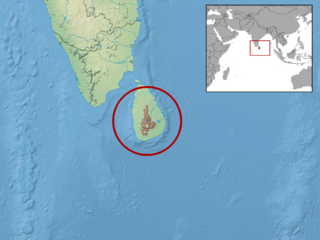
Lankascincus deignani, commonly known as Deignan's tree skink and the Deignan tree skink, is a species of lizard in the family Scincidae. The species is endemic to the island of Sri Lanka.
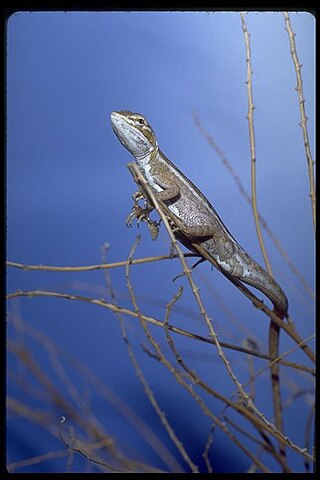
Diporiphora winneckei, also known commonly as the canegrass dragon, canegrass two-line dragon, blue-lined dragon, and Winnecke's two-pored dragon, is a species of small, terrestrial, diurnal lizard in the family Agamidae. The species is endemic to Australia. It is found throughout arid zones of Australia and is also a common house pet.
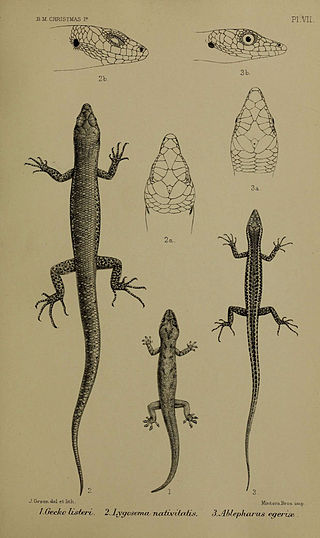
Cryptoblepharus egeriae, also known commonly as the blue-tailed shinning-skink, the Christmas Island blue-tailed shinning-skink, and the Christmas Island blue-tailed skink, is a species of lizard in the family Scincidae that was once endemic to Christmas Island. The Christmas Island blue-tailed skink was discovered in 1888. It was formerly the most abundant reptile on the island, and occurred in high numbers particularly near the human settlement. However, the Christmas Island blue-tailed skink began to decline sharply outwardly from the human settlement by the early 1990s, which coincided with the introduction of a predatory snake and the introduction of the yellow crazy ant in the mid-1980s. By 2006, the Christmas Island blue-tailed skink was on the endangered animals list, and by 2010 the Christmas Island blue-tailed skink was extinct in the wild. From 2009 to 2010, Parks Australia and Taronga Zoo started a captive breeding program, which has prevented total extinction of the species.

Ctenotus strauchii, also known commonly as the eastern barred wedge-snout ctenotus or Strauch's ctenotus, is a small species of lizard in the family Scincidae. The species is endemic to Australia and is found throughout semi-arid and arid regions in most of Australia's mainland states except Western Australia, although one record does exist for Western Australia in 1975.

The Mallee military dragon, also commonly known as the Mallee dragon and the Mallee sand-dragon, is a species of lizard in the family Agamidae. The species is native to the arid parts of southern Australia.
The eastern hooded scaly-foot or eastern scaly-foot is a species of flap-footed lizard found in the complex heaths of the lower west coast and the spinifex grasslands of mainland Australia. They are popular pets and are often mistaken for snakes due to their limbless appearance.

Ctenotus pantherinus, commonly known as the Leopard Ctenotus, is a species of skink endemic to central and western Australia. It's conservation status is currently classified as Least Concern.

The saltbush Morethia skink, or more commonly referred to as saltbush skink, is a species of skink found in Australia. They are part of an 8 species genus of Morethia, which are all endemic to Australia. Akin to other members of the Morethia genus, saltbush skinks feature transparent disks as eye covers and eyelids which are stationary, along with specialised limbs which enable quick traversal of sand dunes. Taxonomically, the species was first classified by German explorer Wilhelm Karl Hartwig in 1871.
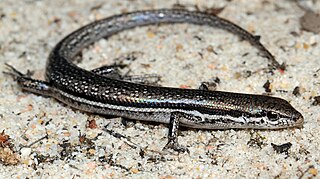
The shrubland Morethia skink is a species of skink endemic to Australia, of the family Scincidae, found in New South Wales, South Australia, Victoria (Australia), Western Australia in Australia.
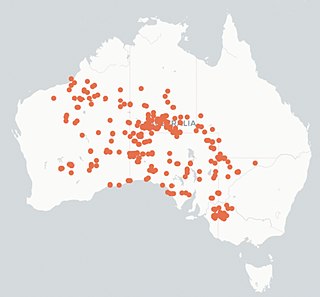
Ctenotus brooksi, also known commonly as Brooks' wedge-snouted ctenotus, the wedgesnout ctenotus, and the sandhill ctenotus, is a species of skink, a lizard in the family Scincidae. The species is endemic to Australia and found in semi-arid regions.

Ctenotus leonhardii, known by the common names Leonhardi's ctenotus, Leonhardi's skink or common desert ctenotus, is a species of skink found in a range of arid and semi-arid regions throughout mainland Australia. The species was named after German anthropologist Moritz von Leonhardi in 1919 and belongs to the genus Ctenotus, one of the largest genera of lizards in Australia.

Boulenger's short-legged skink is a species of lizard in the family Scincidae. The species is endemic to the Philippines.



















